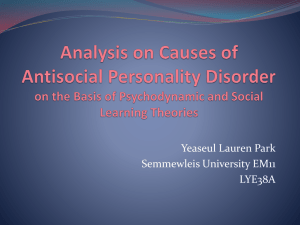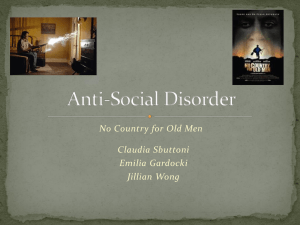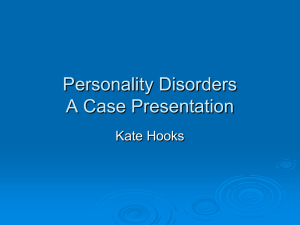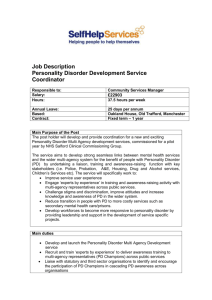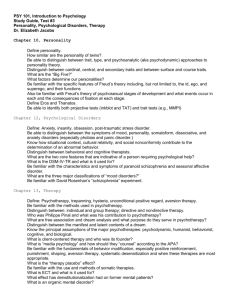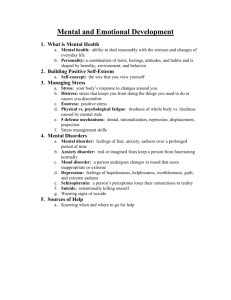Antisocial Personality Disorder
advertisement
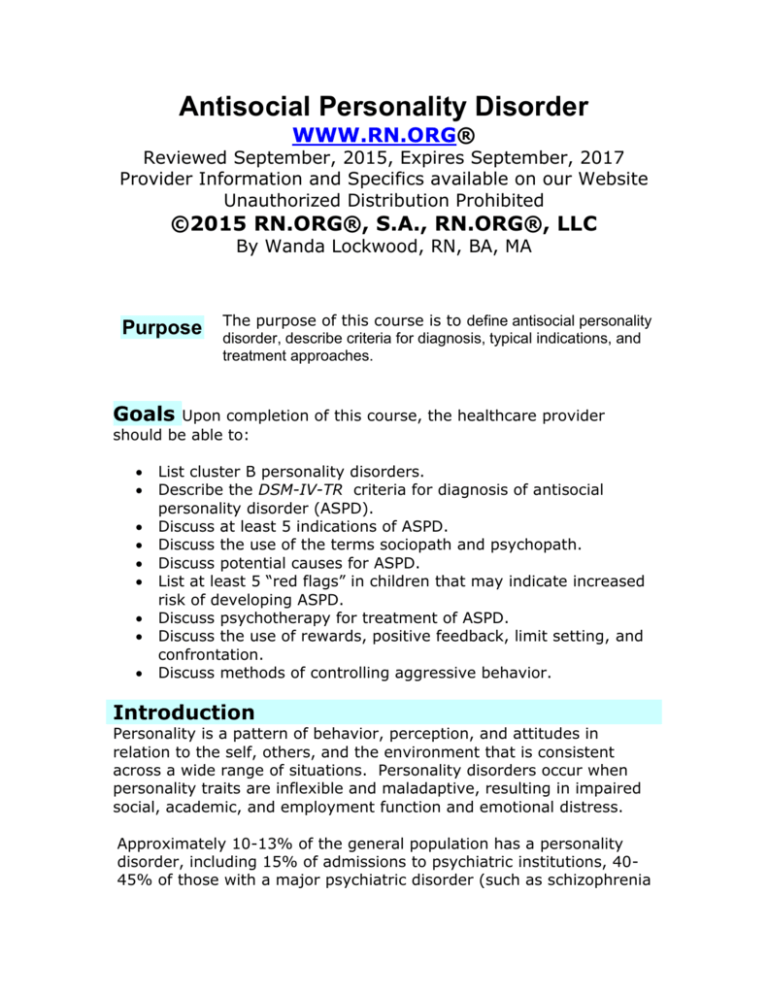
Antisocial Personality Disorder WWW.RN.ORG® Reviewed September, 2015, Expires September, 2017 Provider Information and Specifics available on our Website Unauthorized Distribution Prohibited ©2015 RN.ORG®, S.A., RN.ORG®, LLC By Wanda Lockwood, RN, BA, MA Purpose The purpose of this course is to define antisocial personality disorder, describe criteria for diagnosis, typical indications, and treatment approaches. Goals Upon completion of this course, the healthcare provider should be able to: List cluster B personality disorders. Describe the DSM-IV-TR criteria for diagnosis of antisocial personality disorder (ASPD). Discuss at least 5 indications of ASPD. Discuss the use of the terms sociopath and psychopath. Discuss potential causes for ASPD. List at least 5 “red flags” in children that may indicate increased risk of developing ASPD. Discuss psychotherapy for treatment of ASPD. Discuss the use of rewards, positive feedback, limit setting, and confrontation. Discuss methods of controlling aggressive behavior. Introduction Personality is a pattern of behavior, perception, and attitudes in relation to the self, others, and the environment that is consistent across a wide range of situations. Personality disorders occur when personality traits are inflexible and maladaptive, resulting in impaired social, academic, and employment function and emotional distress. Approximately 10-13% of the general population has a personality disorder, including 15% of admissions to psychiatric institutions, 4045% of those with a major psychiatric disorder (such as schizophrenia or bipolar disorder), and up to 50% of those in outpatient mental health settings. Personality disorders correlate with substance abuse (70-90%), alcohol abuse (60-70%), and criminal activity (70-85%) Diagnosis of personality disorder is usually made 18 because the personality is not set in adolescence; however, indications may be evident during adolescence. Most personality disorders peak during the 20s and 30s and tend to lesson in the 40s. The American Psychiatric Association (DSM-IV-TR) classifies personality disorders into 3 different clusters: A. Odd, eccentric behavior. B. Dramatic, emotional, or erratic behavior. C. Anxious or fearful behaviors. Cluster B personality disorders include antisocial personality disorder, borderline personality disorder [see CE course Borderline Personality Disorder], histrionic personality disorder, and narcissistic personality disorder. The two most commonly found in clinical practice are antisocial personality disorder and borderline personality disorder. What is antisocial personality disorder? While a diagnosis of antisocial personality disorder (ASPD) is delayed until adulthood (18), often alarming indications are often evident during childhood, including acts of violence and substance abuse. Parents may report that clients with ASPD threw temper tantrums and were unmanageable and unresponsive to punishment as children. Clients with ASPD typically had run-ins with the police during adolescence, sometimes including incarceration in juvenile facilities, and were often truant from schools. Some may have been diagnosed with oppositional defiant disorder [see CE course Oppositional Defiant Disorder] or conduct disorder during childhood or adolescence. ASPD occurs 3 to 4 times more frequently in males than females, and up to 75% of those incarcerated are believed to have ASPD. Other Cluster B disorders, such as narcissistic personality disorder, histrionic personality disorder, and borderline personality disorder are often co-morbidities with ASPD, making the condition even more difficult to control and increasing the predisposition toward criminal activity. Narcissistic personalities may engage in white collar crimes while those with histrionic personality disorder may engage in impulsive crimes or crimes to get attention. Those with borderline personality disorder may engage in impulsive crimes or crimes motivated by a desire for revenge. Indications of antisocial personality disorders DSM-IV-TR A) There is a pervasive pattern of disregard for and criteria violation of the rights of others occurring for as long as either childhood, or in the case of many who are influenced by environmental factors, around age 15, as indicated by three or more of the following: Failure to conform to social norms with respect to lawful behaviors as indicated by repeatedly performing acts that are grounds for arrest; Deceitfulness, as indicated by repeatedly lying, use of aliases, or conning others for personal profit or pleasure; Impulsivity or failure to plan ahead; Irritability and aggressiveness, as indicated by repeated physical fights or assaults; Reckless disregard for safety of self or others; Consistent irresponsibility, as indicated by repeated failure to sustain consistent work behavior or honor financial obligations; Lack of remorse as indicated by being indifferent to or rationalizing having hurt, mistreated, or stolen from another; B) The individual is at least 18 years of age. C) There is evidence of conduct disorder with onset before age 15 years. D) The occurrence of antisocial behavior is not exclusively during the course of schizophrenia or a manic episode. Mood & Clients may project a mood or affect different from affect what they are actually feeling to correspond with what they believe is expected of them or will be to their advantage. For example, they may appear relaxed and friendly when they are, in fact, very angry. Cognitive While clients with ASPD do not have disordered processes thoughts, they have distorted perceptions of the world, which they often believe to be cold and uncaring, a justification for their behavior. Clients remain oriented and tend to be of average or aboveaverage intelligence. Judgment Clients exercise poor judgment in that they act impulsively without considering consequences of their actions, seek immediate gratification, and are attracted to thrill-seeking activities, such as extreme sports and reckless driving. They often exhibit little insight into their own problems. Roles/ Clients often have serial or simultaneous relationships Relationships but cannot sustain long-term commitments to others or achieve real intimacy and may abandon family, unable to maintain the role of spouse or parent. They often are able to gain employment but can’t keep jobs because of theft, absenteeism, or boredom. Self-esteem Clients often have very low self-esteem and abuse or take advantage of other people to try to validate their own superiority. Character Clients are often described as pathological liars because they have little or no respect for the truth. They may also tell lies to gain sympathy. Clients often appear as social extroverts, becoming stimulated by abuse of others. Clients typically lack feelings of remorse or guilt, regardless of their activities, and blame others for their problems. While ASPD encompasses behavior attributed to sociopaths or psychopaths, the APA does not use these terms to differentiate between behaviors, suggesting that there is simply a continuum of behavior from bad to worse. However, these terms are in common use to describe clients who exhibit antisocial behavior, and many healthcare providers make a distinction between the two terms (with psychopath being more pathological than sociopath) although, adding to confusion, the terms are also often used interchangeably. Sociopath vs psychopath People categorized as either sociopath or psychopath have committed terrible crimes without remorse or guilt and have shown little or no empathy. Some authorities believe that the distinction is that sociopaths may have some degree of empathy for family or friends while psychopaths completely lack empathy and attack family as easily as strangers. Most authorities agree that psychopaths are at the extreme end of ASPD, typically exhibiting no guilt or remorse about aberrant behavior. Ted Bundy For example, Bernard Madoff, who cheated people out of millions of dollars in an elaborate Ponzi scheme but committed no acts of violence, would probably be described as a sociopath while Ted Bundy, a notorious serial killer who disarmed people by his “normal” behavior and winning smile, is usually referred to as a psychopath. Like Bundy, clients with ASPD may appear very charming and engaging, allowing them to take advantage of people who trust them because of their outward appearance and manner. Others put forth a more violent outward appearance to intimidate. The exact cause of ASPD has not been delineated, but it appears that it results from an interaction between genetic tendencies and the environment. Some people develop antisocial personality disorder as a result of organic brain damage. Studies of those with ASPD show that the amygdala, a part of the brain that mediates learning from one’s mistakes and responding to facial expressions, tends to be smaller, and this may result in a lack of empathy. Cause However, even though the tendency toward ASPD may be there, environmental influences, such as child abuse or neglect, may be the essential trigger. A critical risk factor appears to be parental deprivation during the first 5 years. Another risk factor is physical abuse, which may provide a model of behavior, cause injury to the central nervous system, impairing function, and engender rage. Another important factor is disordered family functioning, including lack of or inconsistent discipline, extreme poverty, single-parent home, removal from the home into foster care, maternal deprivation, and “rescue” when behavior is inappropriate, preventing the person from suffering consequences for actions. Some behaviors found in children <18 are red flags that indicate an increased risk that the child will progress to ASPD: Stealing, mugging. Cruelty to animals. Bullying other children. Starting fires. Sexual assault. Habitual lying. Use of weapons. One study showed a correlation between maternal smoking during pregnancy and ASPD in offspring, perhaps resulting from brain damage from impaired oxygenation of the fetus. Other studies have shown increased rates of ASPD in foster and adopted children, suggesting that early emotional deprivation and moving from one home to another may impair a child’s ability to develop emotional attachments. Additional studies showed that children of antisocial parents are at increased risk of ASPD even if they are separated from their parents at birth. Clients with ASPD often have a history of childhood physical, sexual, or emotional abuse and may have a parent or parents who exhibit antisocial behavior and/or alcohol or other substance abuse. In many cases, these parents were themselves abused or neglected as children, continuing the cycle. What treatment options are available? There is no definitive test for ASPD. Rather, it is diagnosed on the basis of behavior, life history, physical assessment, and psychological testing, including tests for personality disorders. Clients with ASPD rarely seek out treatment and may enter therapy only under orders from a court or while incarcerated. Clients with ASPD, as with all personality disorders, are often very “treatment resistant,” primarily because they don’t perceive that they have a problem. In truth, they may revel in their aggressive or violent behavior and actively resist efforts to change their behavior. Thus, while they may be forced into treatment, they may have little or no motivation to change. Clients who are forced into treatment often do not have the same rights to confidentiality as others because the healthcare provider must report back to the courts or prison officials. In this case, the healthcare provider should clearly divulge to the client what information must be shared in order to establish trust. Psychotherapy is the only treatment usually used for ASPD, as there is no medication that has proven successful in moderating behavior although those with co-morbid psychiatric disorders may take medications to help control those underlying disorders. For example, those with depression may benefit from antidepressants and those with impulsive anger may show some improvement in behavior with mood stabilizers, such as lithium. Psychotherapy Cognitive-behavioral therapy is one of the more successful forms of psychotherapy used for ASPD. CBT uses cognitive restructuring techniques to alter the way clients think about themselves or others and to replace negative patterns of thought with positive. Techniques include: Thought stopping: Clients say, “Stop,” or visualize a stop sign to stop negative or self-critical thoughts. Positive self-talk: Clients reframe negative thoughts into positive ones: “I lost my privileges, but I can recoup them. I know what I need to do.” Decatastrophizing: Clients practice assessing situations more realistically instead of assuming that every action or event is a catastrophe. This often begins by discussing, “What is the worst that could happen?” Group therapy may help to develop trust, build skills, provide support, and improve interpersonal skills. Psychoanalytic therapy has not proven effective as a mode of intervention, so most psychotherapy focuses on reinforcing positive behavior and helping the client to make connections between actions and feelings. Clients with ASPD often have issues with control and authority, so providing rewards/privileges for good behavior when possible rather than removing privileges for bad behavior is often more effective because it leaves the client in control. For example, a client may earn one hour of video games for 2 hours of acceptable behavior. Rewards As clients show progress, longer periods of compliance should be required for rewards. Clients should be kept apprised of these changes. When clients are able to maintain acceptable behavior for extended periods of time, rewards should be greater. Providing positive feedback for honesty and acceptable behavior helps clients understand what they need to do and provides a reward, but positive feedback should be aimed at the behavior and not the person. Effusive or blanket praises, such as “You did so well today,” serve little useful purpose. Positive feedback Good positive feedback should identify the correct behavior and state why it was correct because this helps the client learn new ways of interacting with others. For example, if a client becomes angry with a nurse and gets up and leaves the room rather than arguing, then the appropriate positive feedback would be: “Leaving the room when you were angry was a good strategy because it gave you time to control your anger.” Because clients with ASPD are manipulative and often extremely good liars, the healthcare provider must be consistent in identifying acceptable and expected behaviors, including limit setting: Step 1: State the behavioral limit (unacceptable behavior). Step 2: Identify consequences of violating the behavioral limit. Step 3: Identify the expected or desired behavior. Limit setting An example of limit setting: Client: “Did you go out with your boyfriend over the weekend?” Healthcare provider: “It’s not acceptable to ask me personal questions. If you continue, I will stop this session. We need to spend this time focusing on ways to help you control your anger.” Consequences for unacceptable behavior should be clearly outlined at the beginning of therapy and applied immediately in a non-judgmental and consistent manner. Healthcare providers should avoid coaxing (“We’d like you to…”) or using “should” statements but must state expectations clearly: “You will be expected to stop using lewd and profane language.” Healthcare providers should also avoid making threats, “If you do swear again, you will be placed in seclusion!” Threats rather than consequences may encourage the client to continually test limits. Clients must understand what behavior is unacceptable. In some cases, these unacceptable behaviors should be provided to the client in written form after discussion and may be general (“Stealing”) to specific (“Using lewd language,” or “Teasing Ms. Smith”). Confrontation is another technique that is employed when working with clients with ASPD to deal with manipulative or deceptive behavior. The healthcare provider must remain neutral and matter-of-fact because the client may enjoy causing others frustration, keeping the focus on the problem behavior. Confrontation An example of confrontation: Healthcare provider: “ You said you wanted to control your anger, but you yelled at the aide and refused to go to therapy.” Client: “It was the aide’s fault. I told him I wasn’t ready to talk about this yet.” Healthcare provider: “Therapy is to help you learn better ways to handle your anger, but you can’t learn if you don’t go to the sessions.” Many clients with ASPD lack adequate skills at problem solving, so when they encounter problems, they may react impulsively or even violently. For example, if a client’s car is in the repair shop, he may simply stop going to work instead of looking for alternatives, such as taking a bus. While clients may be cognitively intelligent, they often do not carry out logical problem solving steps and benefit from stepby-step methods of solving problems and practice. Steps include: Identify a problem. Explore different possible solutions. Choose a solution. Evaluate results. Problem solving Clients with ASPD may carry out acts of violence (physical act with intention to harm) or aggression (a threat of harm or act of violence). Aggression usually precedes violence and may include gestures, shouting, prolonged eye contact, and invasion of personal space to intimidate others. It’s essential to intervene or redirect the client before aggression devolves into violence. The client should be directed to take a time out by leaving the area or going to a neutral place until under control. Time out In some cases, clients must be separated from others because of their inability to control their behavior. In this case, seclusion may be used, but attempting to use time out should be tried first because it allows the client more autonomy. With seclusion, the client must go to an environment that Seclusion is separate from others, usually a room, and from which the client cannot leave and is under constant supervision. In extreme cases, clients may be placed in seclusion rooms with padded walls and no furniture or anything the client could use to injury him/herself or others. This type of seclusion is rarely required and should be avoided if at all possible. Physical or chemical restraints are used only in the most extreme cases when clients pose a severe danger to themselves or others, but they must be used following the protocols established for use and in compliance with guidelines by the federal government and accrediting agencies. Restraints The use of physical restraints requires a written policy, an assessment of need, and attempts at other methods to control behavior prior to applying restraints. Chemical restraints use medications, such as lorazepam or haloperidol, to control clients who are extremely agitated or violent and do not respond to less coercive attempts to manage behavior. Oral medications should be offered before injectable. Because substance abuse, including drugs and alcohol, reduces inhibitions, addiction may exacerbate violent or aggressive tendencies, so programs that focus on helping the individual to avoid the use of addictive substances may help them to control their behavior more readily. However, as with other aspects of therapy, clients may not be motivated to change their addictive behavior although those incarcerated may be forced to do so. Substance abuse rehabilitation When clients are at risk for committing violent or aggressive acts toward others, they may be in a constant state of arousal, so modifying the environment, when possible, by lowering lights, keeping noise levels down, having few people in close proximity, and keeping the décor simple may help to calm the person. Environmental modification An interesting study (2009) used extended (80 to 120 sessions) quantitative electroencephalography (QEEB)-guided neurofeedback sessions to treat 9 males and 4 females with ASPD. This treatment approach provided individually tailored neurotherapy sessions based on each patient’s unique EEG and comparisons to age Neurobiofeedback appropriate, normative databases. Twelve of the 13 subjects experienced marked improvement in behavior in symptoms, including impulsivity, deviancy, depression, anxiety, and paranoia, and a 2-year follow-up showed that the improvements persisted. While this is a small study, it suggests that therapy that targets the brain may show promise for the future. Conclusion When caring for clients with ASPD, the healthcare provider should always keep in mind expected outcomes for the client: Avoid injury to self or others. Function within limits of the establishment (no smoking, group activities, etc.). Identify activities that lead to hospitalization/incarceration/problems. Learn positive methods of dealing with anger/stress. Satisfy personal needs without infringing on others. Achieve/Maintain academic/work performance. Achieve/Maintain satisfactory role performance (parent, spouse). Preventive measures need to begin by identifying those at risk during childhood as once personality is set, it is very difficult to change. Those at risk include children living with abuse and poverty. Providing adequate long-term intervention may reduce risk, but the cost is high, and social services rarely provides the types of programs that are needed. It’s important to remember that there is a wide range of behaviors in those with ASPD (not everyone is a psychopath), so some will be more amenable to treatment than others. In some cases, clients may be willing to modify behavior to some degree simply to avoid further incarceration or hospitalization. References Antisocial personality disorder. (n.d.). Antisocial Personality Disorder, Sociopath, Psychopath Information. Retrieved April 15, 2011, from http://www.antisocialpersonality.info/p159404antisocial-personality-disorder.cfm Black, D. (2006, December 12). What causes antisocial personality disorder? PsychCentral. Retrieved April 15, 2011, from http://psychcentral.com/lib/2006/what-causes-antisocialpersonality-disorder/ Dryden-Edwards, R. (2010, May 27). Antisocial personality disorder. MedicineNet. Retrieved April 15, 2011, from http://www.medicinenet.com/antisocial_personality_disorder/ar ticle.htm Fisher, C. (2009, March 13). Patients with anti-social personality disorder benefit from extended neurofeedback. The Behavioral Medicine Report. Retrieved April 15, 2011, from http://www.bmedreport.com/archives/1339 Mayo Clinic staff. (2010, October 8). Antisocial personality disorder. Retrieved April 15, 2011, from http://www.mayoclinic.com/health/antisocial-personalitydisorder/DS00829 McAleer, K. (2010, July 5). Sociopathy vs psychopathy. Forensic Focus. Retrieved April 15, 2011, from http://blogs.psychcentral.com/forensicfocus/2010/07/sociopathy-vs-psychopathy/ Psych Central staff. (2010, June 1). Antisocial personality disorder. PsychCentral. Retrieved April 15, 2011, from http://psychcentral.com/disorders/sx7.htm Townsend, MC. (2008). Nursing Diagnoses in Psychiatric Nursing, 7th ed. Philadelphia, PA: FA Davis Company. Videbeck, SL. (2011). Psychiatric-Mental Health Nursing, 5th ed. Philadelphia, PA: Wolters Kluwer/Lippincott Williams & Wilkins.
